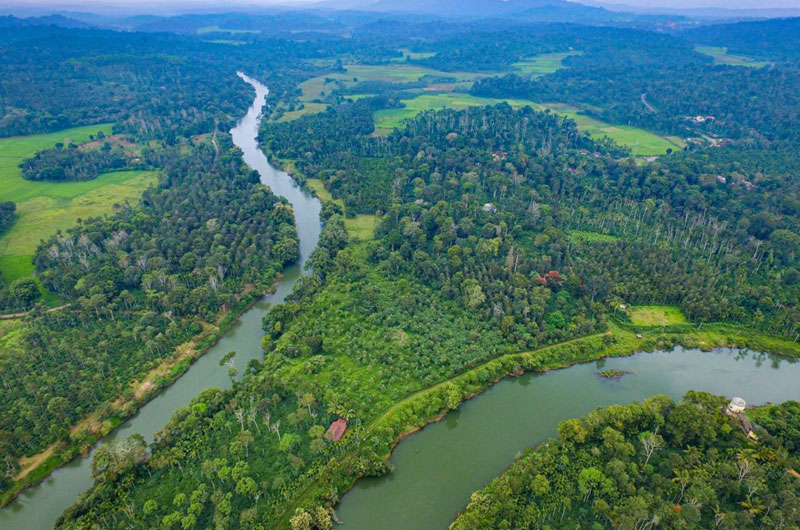
The Cauvery River: The Lifeline of Southern India
The Cauvery River, also known as the Kaveri River, is one of the major rivers in southern India, holding both historical and cultural significance. Originating from the Western Ghats in Karnataka, it flows through Karnataka and Tamil Nadu before emptying into the Bay of Bengal. With a length of approximately 765 kilometers (475 miles), the Cauvery is pivotal for agriculture, economic development, and religious practices in the region. This comprehensive guide explores the Cauvery River’s scenic beauty, historical significance, and practical travel tips for exploring this lifeline of southern India.
1. Overview of the Cauvery River
1.1 Geographic Location and Course
- Origin: The Cauvery River originates from the Brahmagiri Hill in the Western Ghats, located in the Coorg district of Karnataka.
- Course: It flows southeast through Karnataka and Tamil Nadu, passing through cities such as Mysuru, Srirangapatna, and Thanjavur, before reaching the Bay of Bengal.
- Tributaries: Major tributaries include the Kabini, Bhavani, and Arkavathy rivers.
1.2 Importance and Significance
- Economic Impact: The river supports extensive agriculture in its basin, providing irrigation for crops like rice, sugarcane, and coffee. It also contributes to hydroelectric power generation and drinking water supply.
- Cultural and Religious Significance: The Cauvery River is revered in Hinduism, with several temples and pilgrimage sites along its banks. It is also the site of numerous festivals and rituals.
2. Tourism Specialty
2.1 Scenic Beauty
- River Cruises and Boat Rides: Enjoy boat rides and river cruises in serene locations like the Krishna Raja Sagara (KRS) Dam and the Hogenakkal Falls, where the river cascades dramatically.
- Natural Landscapes: The Cauvery River flows through diverse landscapes, including lush forests, rolling hills, and fertile plains, offering scenic beauty for nature enthusiasts.
2.2 Cultural Experiences
- Festivals and Rituals: The Cauvery is central to several cultural events, such as the Cauvery Puthandu (Tamil New Year) and the Cauvery River Festival. These festivals include traditional music, dance, and processions.
- Local Traditions: Visitors can experience local customs related to the river, including traditional boat races and religious ceremonies performed along its banks.
2.3 Adventure and Activities
- Trekking and Hiking: The river’s source in the Western Ghats offers excellent trekking opportunities, with trails leading through lush forests and scenic viewpoints.
- Wildlife Viewing: The river’s basin supports diverse wildlife, including bird species and aquatic life, making it a great spot for wildlife enthusiasts.
3. Locality and Major Cities
3.1 Key Cities Along the Cauvery
- Mysuru: A historic city in Karnataka known for its royal heritage and cultural landmarks, located near the river.
- Srirangapatna: An important historical town with significant temples and fortifications along the Cauvery River.
- Thanjavur: A major city in Tamil Nadu, famous for its Brihadeeswarar Temple and its proximity to the Cauvery Delta.
3.2 Nearby Tourist Spots
- Mysuru:
- Mysore Palace: A grand royal residence with stunning architecture and historical artifacts.
- Chamundi Hill: Offers panoramic views of Mysuru and features the Chamundeshwari Temple.
- Srirangapatna:
- Ranganathaswamy Temple: A significant Vaishnavite temple dedicated to Lord Ranganatha, located in the heart of Srirangapatna.
- Tipu Sultan’s Summer Palace: A historical site showcasing the grandeur of Tipu Sultan’s reign.
- Thanjavur:
- Brihadeeswarar Temple: A UNESCO World Heritage Site known for its architectural marvels and intricate carvings.
- Thanjavur Palace: A historical palace with artifacts and exhibits related to the Chola dynasty.
4. History of the Cauvery River
4.1 Ancient Significance
- Mythological References: The Cauvery River is mentioned in ancient Hindu scriptures and is associated with the goddess Cauvery. It is revered as a sacred river, and its origin is linked to several mythological tales.
- Historical Accounts: The river has been a significant factor in the development of ancient civilizations, with historical references to its importance in irrigation and agriculture.
4.2 Modern History
- Colonial Era: During British rule, the river’s basin was developed for agricultural and irrigation projects. The construction of dams and canals played a crucial role in regional development.
- Post-Independence: The Cauvery River remains central to economic and environmental management, with ongoing projects focused on water management, irrigation, and hydroelectric power generation.
5. Best Time to Visit
5.1 Ideal Seasons
- Winter (November to February): This is the best time to visit the Cauvery River region. The weather is cool and pleasant, ideal for sightseeing, outdoor activities, and river cruises.
- Summer (March to June): Temperatures can be quite high, especially in lowland areas. Early mornings and late afternoons are preferable for outdoor activities.
- Monsoon (July to October): The monsoon season brings heavy rainfall, which can lead to flooding and travel disruptions. However, the lush greenery and rejuvenated landscapes can be appealing.
5.2 Special Events
- Cauvery Puthandu: Celebrated in April, this Tamil New Year festival involves special rituals, processions, and cultural events along the river.
- Cauvery River Festival: Held periodically, this festival includes traditional boat races, cultural performances, and religious ceremonies.
6. Nearby Restaurants and Hotels
6.1 Mysuru:
- Restaurants:
- Rasaiah’s: Known for its traditional South Indian cuisine, including dosas, idlis, and vadas.
- Mylari: Famous for its authentic Mysore masala dosas and other local delicacies.
- Hotels:
- Hotel Lalitha Mahal Palace: A luxurious hotel with historical charm and modern amenities.
- Radisson Blu Plaza Hotel: A premium hotel offering comfort and convenience in a central location.
- Budget Hotels:
- Hotel Roopa: A budget-friendly option with essential amenities and a good location.
- The Olive Star: A budget hotel offering comfortable accommodations and a convenient location.
6.2 Srirangapatna:
- Restaurants:
- Hotel MTR: Offers a range of South Indian dishes with a focus on traditional flavors.
- Sukha Pappu: Known for its local specialties and casual dining atmosphere.
- Hotels:
- Hotel GRS Grand: A mid-range hotel with comfortable rooms and good service.
- Hotel Gopal: A budget-friendly hotel with essential amenities and a convenient location.
- Budget Hotels:
- Hotel Ananya: A budget hotel offering basic amenities and a good location.
- Hotel Krishna: A simple and affordable option with comfortable accommodations.
6.3 Thanjavur:
- Restaurants:
- Bharani Restaurant: Offers traditional Tamil cuisine, including various South Indian specialties.
- Sree Ariya Bhavan: Known for its authentic South Indian dishes and relaxed atmosphere.
- Hotels:
- Hotel Sangam: A premium hotel offering modern amenities and excellent service.
- Hotel Ideal River View: A comfortable hotel with views of the river and good facilities.
- Budget Hotels:
- Hotel Parisutham: A budget-friendly option with basic amenities and a convenient location.
- Hotel Tamilnadu: A budget hotel offering essential facilities and a good location.
Conclusion
The Cauvery River, with its rich history, scenic beauty, and cultural significance, offers a diverse range of experiences for travelers. From exploring the picturesque landscapes and historical landmarks to experiencing vibrant festivals and local traditions, the Cauvery River region is a captivating destination. Whether you’re discovering the river’s origins in Coorg, exploring the cultural heritage of Mysuru and Srirangapatna, or experiencing the historical treasures of Thanjavur, the Cauvery River promises a memorable journey through one of southern India’s most important waterways.
